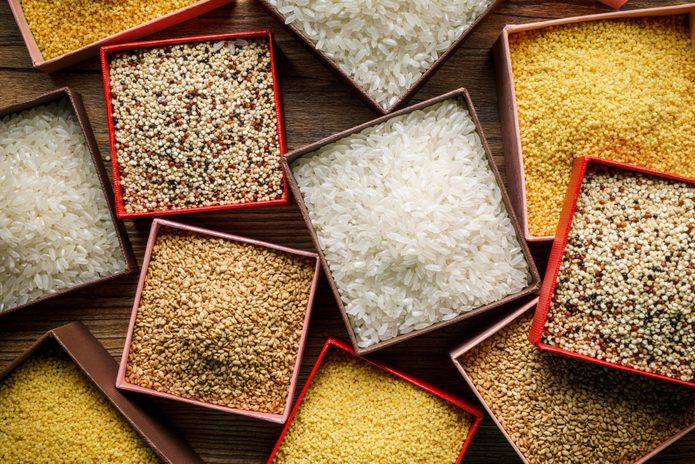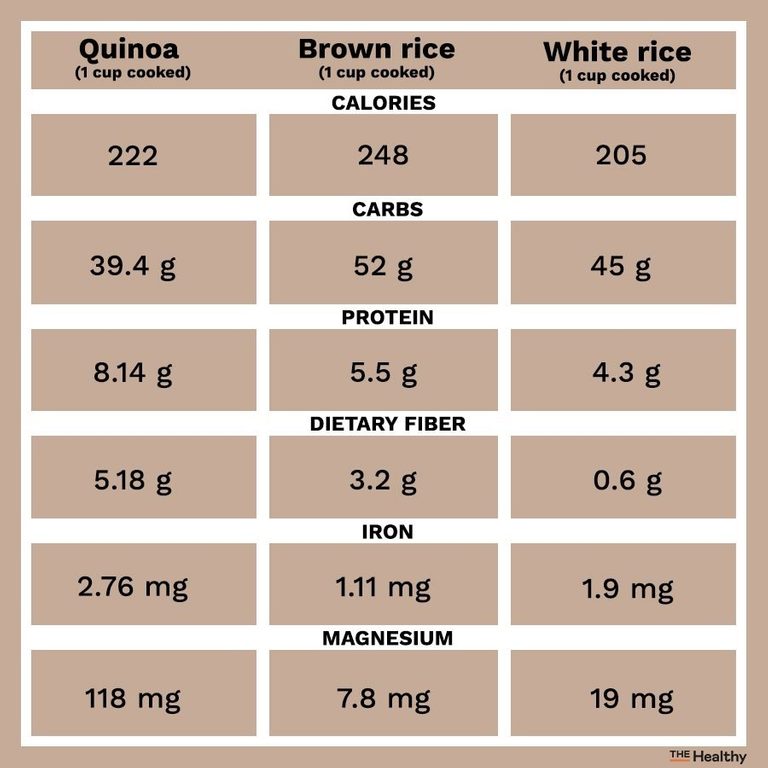Is Quinoa Healthier Than Rice? Here’s What Experts Say

It's a common debate: quinoa vs. rice. Which gluten-free option is best? Here's how quinoa stacks up against both brown and white rice in terms of nutrition, calories, carbs, protein, and health benefits.
Two of the best side dishes to accompany your favourite vegetables and lean proteins are rice and quinoa. They have a lot in common: They’re both gluten free sources of carbohydrate, are quick and easy to make, and pair well with a wide variety of meals. Because they’re so similar, you’ll typically eat one or the other in a meal, not both.
So which should you choose? We compare quinoa vs. rice—both brown and white rice—and explain when to eat each.
What is quinoa?
Quinoa is a seed that people prepare and eat like a grain—that’s why it’s sometimes called a “pseudocereal.” It’s one of the best-known ancient grains, originating in South America and dating back nearly 7,000. There are a few of different varieties: white, red, and black.
It’s often considered a “functional food,” says Malina Malkani, a registered dietitian nutritionist based in Westchester, New York. Though there’s no widely accepted definition of functional foods, they’re generally considered nutrition powerhouses. They pack more than just the essential vitamins and minerals and may be linked to health benefits like disease prevention.
(Related: What Are the Health Benefits of Mushrooms?)
Benefits of quinoa
One of quinoa’s biggest draws is its protein content. It’s a complete protein—a protein that contains all nine essential amino acids our bodies need to get from food—with 8 grams of protein per cooked cup. It’s also high in fibre, with 5 grams per cup of cooked quinoa. The fibre content is why eating quinoa has been linked to lower cholesterol and weight loss, DeFazio says. The seed is rich in minerals like magnesium, manganese, phosphorus and zinc. And it’s naturally gluten free.
Another benefit of quinoa is its low glycemic index (it has a GI of 53), which makes it a good choice for blood sugar control, says registered dietitian nutritionist Lisa DeFazio.
What is rice?
Rice is a member of the Poaceae (grass) plant family. As a starchy grain, it’s a good source of carbohydrates and a staple around the world. There are more than 40,000 varieties, including white, red, brown, basmati, jasmine, and wild rice. Brown rice is what’s known as a whole grain, meaning most of the grain remains intact after processing. White rice, on the other hand, goes through greater processing, so the hull, bran, and germ are removed.
(Related: What is Teff? What to Know About This Gluten-Free Ancient Grain)
Benefits of rice
All rice is gluten free, but other nutritional benefits differ based on the type of rice. Black and red rice, for example, are high in anthocyanins, according to the journals Food Chemistry and the Journal of Agricultural and Food Chemistry. Anthocyanins are pigments that give plant foods color. And according to a study published in the journal Food & Nutrition Research, these potent compounds combat oxidative stress in the body.
Wild rice and brown rice have similar nutrition profiles. They are both good sources of manganese, iron, and fibre. Brown rice is especially rich in lignans, which are associated with reduced cholesterol and lower blood pressure, according to a study in Nutrition Reviews. This type of rice is also linked to weight loss and blood sugar control, according to research in the journal Diabetes Technology & Therapeutics.
Meanwhile, white rice is a good source of easy-to-digest-carbs, but it doesn’t have many other nutrients.
Quinoa vs. rice
It’s challenging to compare quinoa and rice because there are so many different types of rice (and different varieties of quinoa, too). Here’s how they stack up in terms of calories, carbs, protein, fibre, iron and magnesium.
(Related: 5 Types of Rice: Which Is the Healthiest?)

Protein and fibre
Quinoa and rice may have a lot of similarities (their calorie content is comparable, for instance), but where they differ most (and where quinoa wins) is in their fibre and protein content. A cup of quinoa contains twice the protein of white rice. As for quinoa vs. brown rice, despite brown rice’s higher protein content than white, it can’t beat quinoa.
The quality of protein in quinoa is ideal, too. As a complete protein, it contains the essential amino acids (precursors to protein) we need to get from food. Brown and white rice don’t, says to Sandra J. Arévalo, RDN, national spokesperson for the Academy of Nutrition and Dietetics.
Quinoa wins when it comes to fibre, too: It has about 5 grams more fibre than white rice and a almost 2 grams more than brown rice. “The more fibre you eat, the better,” Arévalo says. “It helps to regulate your bowel movements, lower your cholesterol, and prevent some types of cancer.” And quinoa’s low glycemic index means it may help regulate blood sugar levels. “Quinoa is a great choice for people with diabetes, as it will not spike glucose levels like white rice, due to its fibre and protein content,” DeFazio says.
White rice, on the other hand, has a high glycemic index. So it may elevate blood sugars more, says Arévalo, who is also a certified diabetes care and education specialist.
Micronutrients and antioxidants
The mix of vitamins and minerals is part of the reason why DeFazio prefers quinoa over rice. “Quinoa is high in fibre, minerals, antioxidants, and all nine essential amino acids,” she says. “Quinoa is one of the healthiest foods you can eat.” In addition to protein and fibre, quinoa is higher than brown rice in iron and potassium, and is generally more nutrient-dense, says Malkani.
But don’t count rice out completely. Malkani says brown rice is very high in manganese and is a good source of B vitamins, including niacin, riboflavin, and folate. And rice shares some amino acids with quinoa, Arévalo says.
(Related: What are the Health Benefits of Romanesco?)
Brown rice and arsenic
Brown rice accumulates higher-than-average amounts of mercury and arsenic, both toxic elements. The arsenic content of rice is of particular concern—the FDA has even placed a high priority on monitoring it—because the food is a leading source of arsenic.
“Rice tends to contain higher levels of inorganic arsenic because it grows in flooded fields,” Malkani says. The specific amount of arsenic in rice varies depending on the brand as well as the type of rice. According to the Food and Drug Administration (FDA), arsenic is more likely found in brown rice than white because arsenic accumulates in the bran. White rice is stripped of the bran, so it contains less arsenic.
The same report from the FDA concluded that the arsenic levels in 1,300 types of rice samples were too low to cause immediate concerns but could pose risks with long-term exposure. High doses of arsenic intake are associated with various health issues, such as cancer.
If you want to reduce or limit your exposure to arsenic through rice, mix up your grain consumption and use the following methods. A 2015 study published in PLOS One found that cooking rice using a 12:1 ratio of water to rice removes 50 to 70 percent of the arsenic.
Other research recommends washing rice before cooking, which a study in the Journal of Environmental Monitoring found may remove 10 percent of the arsenic.
Eating rice in moderation as part of a balanced diet can help you avoid getting too much arsenic. Instead of making rice your go-to grain, switch things up during the week.
Quinoa vs. rice: Which is healthier?
It’s safe to say both quinoa and rice can have a place in a healthy diet. Both are versatile and nutrient-packed additions to your diet, so you might eat quinoa one night and brown rice the next. “A well-balanced diet is all about balance and variety,” Arévalo says. “Including quinoa and rice regularly is key to enjoy the difference in flavours and nutritional content.”
That said, all three dietitians agree that quinoa is the better option. “For those who are looking for a way to add more plant-based protein to a meal, quinoa is a better choice than brown rice,” says Arévalo.
Plus, quinoa is one of the few plant foods that contains adequate amounts of all nine essential amino acids. Meanwhile, rice is mainly carbohydrates. With its amino acid, fiber, and protein content, quinoa is the more nutritious option, DeFazio says.
The bottom line
DeFazio personally prefers the taste and texture of white rice, especially with sushi and in Mediterranean food. If she has a vegetarian meal, however, she chooses quinoa for the added protein.
Malkani likes using them both as a base for grain bowls, as a side dish with protein and vegetables, or as a carbohydrate addition to stews. And they’re both a great way to make salads more satisfying.
If Arévalo feels her meal lacks nutrients—say, if she’s eating grilled chicken with carrots—she adds quinoa as starch to boost the meal’s nutritional value. On the other hand, if she eats a dish like beans, spinach, and fish, she prefers rice.
Consider making both quinoa and rice parts of a healthy, well-balanced diet. And keep in mind that food shouldn’t be labeled “good” or “bad.”
Now that you know about quinoa vs rice, this is what you need to know about choosing a healthy bread.




